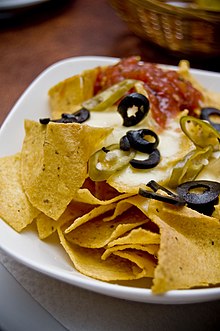 Nachos with tortilla chips, melted or not melted cheese, olives, jalapeño peppers, sour cream, and salsa | |
| Course | Snack, appetizer, or main course |
|---|---|
| Place of origin | Mexico |
| Region or state | |
| Associated cuisine | Tex-Mex cuisine |
| Created by | Ignacio Anaya |
| Main ingredients | Tortilla chips, cheese |
| Ingredients generally used | Various toppings |
Nachos are a Tex-Mex culinary dish[2][3][4][5] consisting of tortilla chips or totopos covered with cheese or cheese sauce, as well as a variety of other toppings and garnishes, often including meats (such as ground beef or grilled chicken), vegetables (such as chili peppers, lettuce, tomatoes, and olives), and condiments such as salsa, guacamole, or sour cream. At its most basic form, nachos may consist of merely chips covered with cheese (usually cheddar or American cheese), and served as an appetizer or snack, while other versions are substantial enough as a main course. The dish was created by, and named after, Mexican restaurateur Ignacio "Nacho" Anaya, who created it in 1943 for American customers at the Victory Club restaurant in Piedras Negras, Coahuila.[6][7][8][9][10][11]
- ^ Tijerina, Edmund. "How Nachos Became an International Hit". Texas Highways.
- ^ Bays, Harold Edward; Muñoz-Mantilla, Doris X.; Morgan, Ryan; Nwizu, Chima; Garcia, Theresa “Tess” (1 March 2022). "Obesity Pillars Roundtable: Obesity and Diversity". Obesity Pillars. 1: 100008. doi:10.1016/j.obpill.2021.100008. ISSN 2667-3681. PMC 10662096. PMID 37990704.
Traditional Mexican foods include pork goat, seafood, and chicken, white cheeses, often corn tortillas, crema, lime juice, and raw onions. Examples of Tex-Mex foods include nachos, chili con carne or queso, and fajitas.
- ^ Wheaton, Dennis Ray; Carroll, Glenn R. (1 January 2017). "Where did "Tex-Mex" come from? The divisive emergence of a social category". Research in Organizational Behavior. 37: 143–166. doi:10.1016/j.riob.2017.09.003. ISSN 0191-3085.
Tex-Mex typically implies concretely items such as chili con carne, nachos, fajitas and combination plates, among other food items; it usually also implies yellow cheese, cumin, corn chips, and chili powder among other ingredients.
- ^ Colllins, Kimberly; Kohout, Michal (2020). "Regional Geographies of the US-Mexico Border". In Jackiewicz, Edward L.; Bosco, Fernando J. (eds.). Placing Latin America: Contemporary Themes in Geography (Fourth ed.). Lanham: Rowman & Littlefield. ISBN 9781538126295.
The lower Rio Grande region is considered the heartland of Tex-Mex culture, partly defined by its distinct food such as fajitas, nachos, and enchiladas...
- ^ "Who Invented Nachos?". HuffPost. 15 May 2012.
While nachos are often served at Mexican-American restaurants, they're not a typical Mexican dish. And even though nachos were invented in Mexico, they were created for an American palate.
- ^ Saavedra, Tania Alemán (2019-08-15). "Ignacio Anaya, el mexicano que inventó los nachos". México Desconocido (in Spanish). Retrieved 2020-11-04.
- ^ "Lo que conocemos como nachos, en realidad se llaman totopos | CM Abastos". www.cmabastos.es. Retrieved 2020-11-04.
- ^ Spanish Word Histories and Mysteries: English Words That Come From Spanish. Houghton Mifflin Harcourt. 2007. p. 157. ISBN 9780547350219. Archived from the original on 17 May 2015. Retrieved 7 March 2015.
- ^ Strong, Franklin (2012). Herrera-Sobek, Maria (ed.). Celebrating Latino Folklore: An Encyclopedia of Cultural Traditions. ABC-CLIO. p. 825. ISBN 9780313343407. Retrieved 26 March 2016.
- ^ Cite error: The named reference
:0was invoked but never defined (see the help page). - ^ "Action Line". Corpus Christi Caller-Times. 25 March 1974.